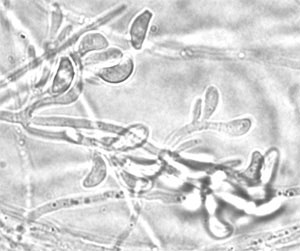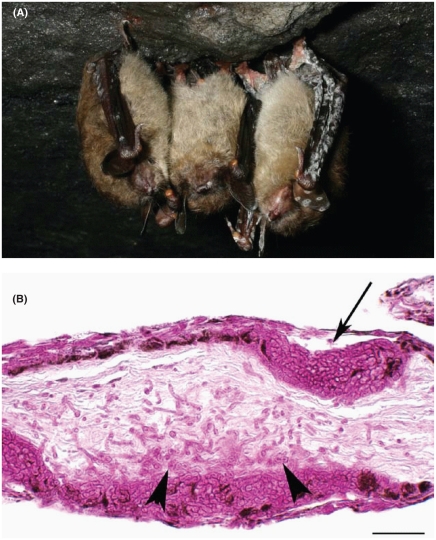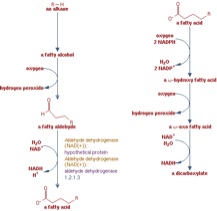Geomyces Destructans
A Microbial Biorealm page on the genus Geomyces Destructans

Classification
Kingdon: Fungi
Subkingdom: Dikarya
Phylum: Ascomycota
Subphylum: Pezizomycotina
Class: Leotiomycetes
Order: Helotiales
Family: Myxotrichaceae
Genus: Geomyces
Species: Geomyces destructans
Description and Significance

Geomices destructans is a fungus thought to be responsible for the large number of bat deaths in New England over the last several years. It first presented itself in the US in 2006 and then in Europe specifically France, in 2009. Until recently G. destructans was thought to be a normal resident inhabiting bats around the world. Further research links this to “white nose syndrome,” and even more recent research shows a 100% match between the DNA of G. destructans and the fungus found on the dead bats [1]. (Chaturvedi et al) Further study is needed on this subject; reachers do not seem to be sure if the fungus is stemming from pest control measures or how and why this has recently devastated bats around the world.
Since first observation near Albany, NY in 2006, white nose syndrome has decimated populations of cave-hibernating bats in the northeastern United States, with mortality rates of 75-95%. In 2009, the infection area extended from northeastern New Hampshire to southwestern Virginia and expanded into Tennessee and Canada in 2010 [2]. Outside of North America, G. destructans has also been observed in colonized bats across Europe. It is not yet obvious how the infection is influencing the bat populations in Europe [10]. Description and Significance
.
Genome Structure
A total of 9075 genes coding for proteins have been sequenced for Geomyces destructans in a genome of 29,706,106 base pairs to code for them. Liner mitochondrial DNA has also been sequences but little information is available on genetic specifics at this time. (NCBI)http://www.ncbi.nlm.nih.gov/pubmed/.
Metabolism

"Fatty acid ω-oxidation in Geomyces destructns was researched by metacycy. http://metacyc.org/. Geomyces, along with other industrial yeasts, are capable of using fatty acids and alkanes as carbon sources. The methyl group at the end of the molecule is initially oxidized to a hydroxyl group, then to an oxo group, and terminally to a carboxyl group. The long chain of dicarboxylates derived from ω-oxidation then go into the β-oxidation pathway for further breakdown [6]. In the environment, polyunsaturated fatty acids, specifically linoleic and a-linolenic acid, are important for hibernating animals. Bats severely affected by White Nose Syndrome have been shown to exhibit higher amounts of α-linolenic acid in their white adipose tissue [7]. Contrariwise, bat species’ not heavily afflicted by white nose syndrome have higher amounts of linoleic acid in their white adipose tissue. In order for G. Destructans to survive it must utilize the α-linolnic acid as a carbon source. Dietary fatty acids can be excreted through sebaceous glands on the bat, which the fungus comes into contact with. G. destructans is unable to metabolize linoleic acid as a carbon source but may metabolize a-linolenic acid. If bats differ in their relative ratios of fatty acids this may play an important role in species, diet, and range specificity to white nose syndrome and hence bat survival [7]."
Ecology
Due to the metabolic diversity in the genus Bacillus, bacilli are able to colonize a variety of habitats ranging from soil and insects to humans. Bacillus thuringiensis parasitizes insects, and is commercially used for pest control. Although the most well known of the bacilli are the pathogenic species, most Bacillus are saprophytes that make their living off of decaying matter. Still others, namely Bacillus subtilis, inhabit the rhizosphere, which is the interface between plant roots and the surrounding soil. The plants roots and associated biofilm can have a significant effect on the chemistry of the soil, creating a unique environment.
It has recently been shown that Bacillus subtilis engages in cannibalism. They use cannibalism as the easy way out in extreme cases. For survival in harsh environments, bacilli can form spores, but it is very costly to them energy-wise. An easier way is for the bacteria to produce antibiotics that destroy neighboring bacilli, so that their contents may be digested allowing for the survival of a few of the bacteria. Essentially, what they are doing is snacking on their fellow bacilli, to tide them over, hoping for the environment to pick back up.
Pathology
Bacilli cause an array of infections from ear infections to meningitis, and urinary tract infections to septicemia. Mostly they occur as secondary infections in immunodeficient hosts or otherwise compromised hosts. They may exacerbate previous infection by producing tissue-damaging toxins or metabolites that interfere with treatment.
The most well known disease caused by bacilli is anthrax, caused by Bacillus anthracis. Anthrax has a long history with humans. It has been suggested that the fifth and sixth plagues of Egypt recorded in the Bible (the fifth attacking animals, the sixth, known as the plague of the boils, attacking humans). In the 1600s anthrax was known as the "Black bane" and killed over 60,000 cows. Anthrax has more recently been brought to our attention as a possible method for bioterrorism. The recent anthrax mailings have brought acute public attention to the issue and sparked extensive research into the devastating disease.
Anthrax is primarily a disease of herbivores who acquire the bacterium by eating plants with dust that contains anthrax spores. Humans contract the disease in three different ways. Cutaneous anthrax occurs when a human comes into contact with the spores form dust particles or a contaminated animal or carcass through a cut or abrasion. Cutaneous anthrax accounts for 95% of anthrax cases worldwide. During a 2-3 day incubation period the spores germinate, vegetative cells multiply, and a papule develops. Over the following days the papule ulcerates, dries and blackens to form the characteristic eschar. The process is painless unless infected with another pathogen.
Gastrointestinal anthrax is contracted by ingesting contaminated meat. It occurs in the intestinal mucosa when the organisms invade the mucosa through a preexisting lesions. It progresses the same way as cutaneous anthrax. Although it is extremely rare in developed countries, it has a very high mortality rate.
Pulmonary anthrax is the result of inhaled spores that are transported to the lymph nodes where they germinate and multiply. They are then taken into the blood stream and lymphatics culminating in systemic arthritis which is usually fatal.

Phages
Due to the danger of anthrax being used in biological weapons, research has been put into other methods, besides the highly controversial vaccine, to defend against the deadly disease. A recently discovered bacteriophage, the gamma phage, attacks Bacillus anthracis, and researches are optimistic about its clinical application. The bacteriophage is highly selective, and is extremely effective in lysing B. anthracis cells, while ignoring those of its closely related counterparts B. cereus and B. thuringiensis. The gamma phage has been over 80% effective in treating infected mice that were in the late stages of the disease, essentially rescuing them from almost certain death. There is the obvious concern that anthrax will develop strains that are immune to this treatment, and we will be right back where we started. Researchers say that this is unlikely because the only way to evade this predator would be a mutational change in cell wall structure to prevent the virus from binding, and this would kill the bacterium.
Medicine
Despite the pathogenic capabilities of some bacilli, many other species are used in medical and pharmaceutical processes. These take advantage of the bacteria's ability to synthesize certain proteins and antibiotics. Bacitracin and plymixin, two ingredients in Neosporin, are products of bacilli. Also, innocuous Bacillus microbes are useful for studying the virulent bacillus species that are closely related. B. subtilis has multiple carbohydrate pathways, representing the variety of carbohydrates found in the soil.
References
Innovation in Europe: The decoding of the Bacillus subtilis genome
University of Texas Medical Branch: Bacillus
University of Wisconsin-Madison: Bacillus anthracis and anthrax
Wipat, Anil & Colin R. Hardwood. 1999. The Bacillus subtilis genome sequence: the molecular blueprint of a soil bacterium. FEMS Microbiology Ecology, Vol. 28: 1-9.
